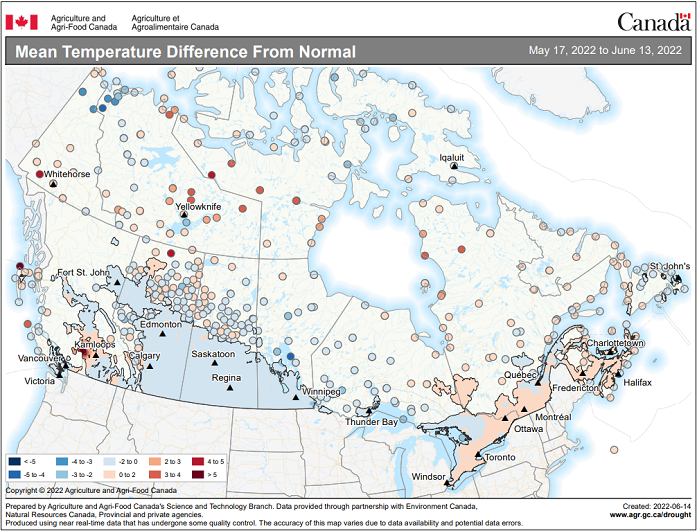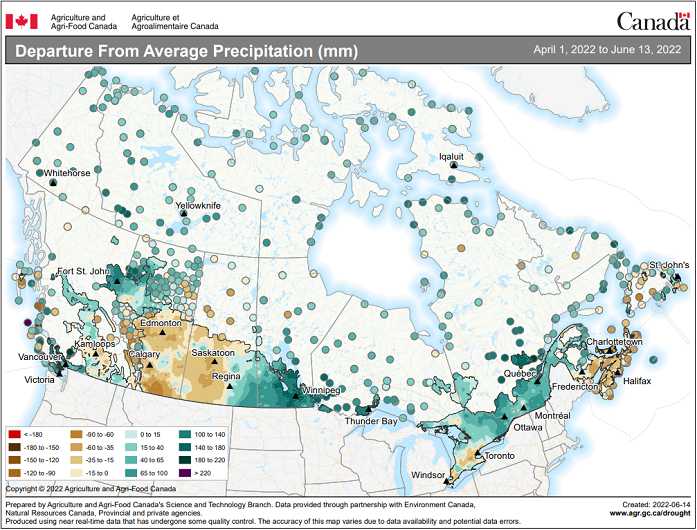Principal field crop areas, June 2022
Archived Content
Information identified as archived is provided for reference, research or recordkeeping purposes. It is not subject to the Government of Canada Web Standards and has not been altered or updated since it was archived. Please "contact us" to request a format other than those available.
Released: 2022-07-05
Canadian farmers reported planting more wheat, lentils, corn for grain and oats, but fewer acres of canola, barley, soybeans and dry peas, according to the 2022 June Field Crop Survey.
Conditions varied across the Prairie provinces early in the growing season. Temperatures were generally below normal for large portions of western Canada. In southern Alberta and western Saskatchewan, precipitation at the beginning of the growing season was well below normal, exacerbating already dry conditions from the previous year. These conditions provided producers the opportunity to seed at a near-normal pace.
By contrast, Manitoba, southeastern Saskatchewan and parts of northern Alberta received more precipitation than normal at the start of the growing season. While above-average precipitation in these areas helped to alleviate soil moisture deficits caused by the previous year's drought, seeding was delayed as a result. This was most notable in Manitoba, where flooding resulted in seeding progress well below average at the time of collection.
In general, seeding in eastern Canada progressed well. Temperatures were at or above normal early in the growing season. Precipitation was below normal in parts of southern Ontario and the Maritimes, while northern and eastern parts of Ontario and most of Quebec received above-normal precipitation.
Aside from environmental conditions, high input prices, high crop prices resulting from low national and global supply, and the ongoing conflict in Ukraine likely impacted farmers' final seeding decisions.
Wheat area rises to highest level in a decade
Nationally, farmers reported planting 25.4 million acres of wheat in 2022, up 8.7% from 2021. Higher total wheat area was led by spring wheat area, which rose 10.5% to 18.2 million acres, and higher durum wheat area, which rose 8.6% to 6.0 million acres. Winter wheat, grown predominantly in eastern Canada, decreased 12.7% to 1.2 million acres. The increase in total wheat area may be attributable to favourable prices and strong global demand.
In Saskatchewan, wheat area increased 10.4% to 13.2 million acres as spring wheat area rose 11.7% to 8.3 million acres and durum wheat area rose 7.6% to 4.9 million acres.
Alberta producers reported planting 7.6 million acres of wheat, up 9.6% from the previous year, led by higher spring wheat area, which increased 9.3% to 6.4 million acres. Durum wheat area in the province rose 9.9% to 1.1 million acres.
Farmers in Manitoba reported that total wheat seeded area increased 12.1% to 3.2 million acres.
Canola area down despite strong demand
Farmers reported planting 21.4 million acres of canola in 2022, down 4.7% from the previous year. Despite high prices, area may have decreased as farmers shifted to alternate crops such as cereals.
Farmers in Saskatchewan reported planting 11.4 million acres of canola, down 6.0% from 2021.
In Alberta, farmers reported planting 6.5 million acres of canola, down 3.0% from the previous year.
Seeded area decreased 4.3% in Manitoba, falling to 3.3 million acres.
Soybean area lower in 2022
Soybean area edged down 0.9% to 5.3 million acres in 2022. While global demand for soybeans remains high, poor weather conditions in parts of Manitoba may have impacted total seeded area, as some farmers possibly chose shorter season crops because of seeding delays.
In Ontario, farmers reported planting 3.1 million acres of soybeans, up 4.9% from a year earlier.
Manitoba farmers reported lower soybean area, decreasing 13.8% to 1.1 million acres, the lowest area seeded in the province since 2013, possibly because of poor field conditions.
Farmers in Quebec reported seeding 955,900 acres of soybeans in 2022, rising 3.3% from the previous year.
Barley planting declines from a year earlier, while oats rise
Farmers planted 7.0 million acres of barley in 2022, down 15.1% from a year earlier. Barley area decreased 25.0% in Saskatchewan to 2.8 million acres. Farmers in Alberta also planted less barley, decreasing 8.1%, while barley area in Manitoba rose 2.7%.
Farmers reported planting 16.1% more oats, up to 4.0 million acres. In Saskatchewan, the largest oat-producing province, planting rose 14.5% to 1.9 million acres. Producers also reported higher area in Alberta (+22.7%) and Manitoba (+13.8%).
Corn for grain up from previous year
At the national level, farmers reported seeding more corn for grain in 2022, rising 4.1% to 3.6 million acres from the previous year.
In Ontario, where over 60% of all corn for grain in Canada is grown, farmers reported a 6.0% increase in seeded area to 2.3 million acres.
In Quebec, farmers reported planting 892,300 acres of corn for grain, up 0.7% compared with 2021.
Lentil area edges up, while dry pea area falls
Canadian farmers reported planting 4.3 million acres of lentils in 2022, up 0.4% from a year earlier.
Nationally, farmers reported seeding 11.8% less area with dry peas compared with 2021, falling to 3.4 million acres. Saskatchewan dry pea area decreased by 290,800 acres, while Alberta area fell 103,800 acres.
Note to readers
The 2022 June Field Crop Survey, which collects information on field crop seeded areas in Canada, was conducted from May 13 to June 12, 2022, with approximately 25,000 farms. They were asked to report their seeded areas of grain, oilseeds and special crops.
June seeded acres are subject to updates from subsequent surveys during the current crop year. Data on final acreages for 2022 will be released on December 2, 2022, and will be subject to revision for two years.
Field crop surveys collect data from Quebec, Ontario, Manitoba, Saskatchewan and Alberta at all survey cycles. However, they collect data twice a year (in the June iteration of the Field Crop Survey on seeded areas and in the November iteration of the Field Crop Survey on final production) for Newfoundland and Labrador, Prince Edward Island, Nova Scotia, New Brunswick and British Columbia, which represent between 2% and 4% of national totals. Therefore, Canadian totals for March include carry-over data for these provinces from their preceding November survey. Canadian totals for July include carry-over data for seeded area for all provinces from their preceding June survey.
During collection of the 2022 June Field Crop Survey, field conditions in Manitoba were very wet, resulting in lower seeding progress than normal. Respondents were asked to report what was or will be seeded in 2022. Some parts of the province had declared a state of emergency because of flooding. Respondents who were impacted by this state of emergency were excluded from collection and were imputed using the field crop survey methodology.
Release calendar: The dates for upcoming releases of stocks, areas and production of principal field crops are available online.
Estimates for genetically modified corn for grain and soybeans are now available for all provinces beginning with the 2018 reference year.
In this release, percentage changes are calculated using unrounded data.
Data for June 2022 are compared with final 2021 data.
For more information on agriculture and food, visit the Agriculture and food statistics portal.
Contact information
For more information, or to enquire about the concepts, methods or data quality of this release, contact us (toll-free 1-800-263-1136; 514-283-8300; infostats@statcan.gc.ca) or Media Relations (statcan.mediahotline-ligneinfomedias.statcan@statcan.gc.ca).
- Date modified:





